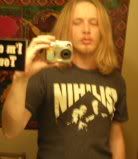The Plumbers Set Up Shop, Inspired By Nazis
In most action movies there's a scene or series of scenes showing how the group of heroes come together, an introduction to show each individual member's story before the whole commences to action. Liddy does the same thing in Will, with one important difference: his crew is the gang on the other side, the villains. Imagine Kurasawa had shown how the bandits, instead of the Seven Samurai, had been recruited, and that's very much the scene Liddy relates here. The context is soon after the New York Times published the Pentagon Papers and, about a month later the Times scooped the secret U.S. plans for the SALT II talks with the Soviets. Nixon and Dr. Death Henry Kissinger were livid, something had to be done:On July 24 President Nixon conferred with John Ehrlichman and Bud Krogh about the devastating problem of leakage to the press of the highest classifications of national security information. Krogh came from the meeting shaken and soon afterward spoke to me. The President, Krogh said, was absolutely furious, as was Henry Kissinger, about the "deliberate" leaks. Krogh and [David] Young were to orchestrate a government-wide search to find the leakers and root them out. It had the "absolute highest priority." Daniel Ellsberg, who had been made a hero by the press, was now the symbolic personification of all the leakers. He had been indicted on 28 June, and it was mandatory that the prosecution succeed. Krogh, Young, and I were to supervise and coordinate all this for the White House. I had my marching orders.
[...]
From his staff Bud Krogh assigned a classically blond, precise, and efficient German-American to Room 16 [the Plumbers' office]. Her name was Kathleen Chenow. The CIA came over to give us the highest clearances and to take our oaths not to compromise them. One, for example, was so high that just the first letter of the identifying code word was classified SECRET while the word itself was TOP SECRET and the information protected so classified the Holy Ghost could only give it to God the Father on a need-to-know basis. I was briefed on "Project Jennifer": the attempt, by means of the Glomar Explorer, to raise the Soviet submarine sunk in the Pacific. It is the only one I can reveal to this day -- because it is already blown -- but my clearances included the high-technology satellite intelligence systems and matters of similar seriousness. I received them because my work on the new project required access to Pentagon files. Nevertheless, the top drawer of the file safe in Room 16 was forbidden even to me. It was, I believe, where David Young kept results of the Kissinger-ordered and other exceptionally sensitive wiretaps.
With Young so deeply involved in trying to locate the source of the SALT leak and Krogh maintaining his office upstairs, I was the only one left to do what obviously needed to be done: we couldn't just "wing" such an extraordinarily complex and sensitive assignment, so I undertook to organize the unit.
The first thing required, I believed, was our own sensitivity indicator to distinguish our product from that of the agencies we were coordinating and other White House sources. As history was to prove, compromise of the kind of documents we were generating would be disastrous. Our organization had been directed to eliminate subversion of the secrets of the administration, so I created an acronym using the initial letter of those descriptive words. It appealed to me because when I organize, I am inclined to think in German terms and the acronym was also used by a World War II German veterans organization belonged to by some acquaintances of mine, Organisation Der Emerlingen Schutz Staffel Angehorigen: ODESSA.
On the blackboard, in German for clarity and added security, I diagrammed the new ODESSA organization. The only exception to the German was the use, common in the Nixon White House, of the Greek letter and mathematical symbol, pi, as a symbol for the President. As I diagrammed, something puzzled me. I knew how the Nixon administration operated; at the apex of power there was very little room and the jockeying for position was intense. Anytime something important was going on, those with power, derived from proximity to the President, were careful to be represented, either in person or by a trusted proxy.
The Ehrlichman presence was Krogh. Kissinger was represented by David Young, even though Young tried to disassociate himself from Kissinger by saying that he had not been assigned his role by "Henry," as he had called him; he said he had quit as Kissinger's appointments secretary because he had gotten to the point where he could no longer "lie all day for Henry." I owed my position to John Mitchell. The only other power not represented was Charles Colson. It was inconceivable to me that Colson would not have a presence in such an enterprise. As these thoughts were going through my head, Kathleen Chenow entered to tell me there was someone in the outer office inquiring about reviewing some of our holdings on Ellsberg. Dave Young was busy. Would I see him? I walked out and was introduced to Howard Hunt.
E. Howard Hunt presented himself as a consultant working for Charles Colson sent down to Room 16 to review whatever we had available on Ellsberg. The empty space on my organization chart was filled. All the heavy hitters were accounted for.
Jesus, what a fucking fascist -- the man and the operation, even down to the Aryan secretary. The original ODESSA, of course, was the network that smuggled high-profile Nazis -- often the worst war criminals among them -- to safety in the West, particularly to South America. I'd very much like to know who in ODESSA were Liddy's "acquaintances," and how well he knew them, what the nature of their relationship was.





<< Home